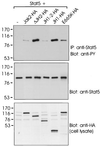Regulation of the Jak2 tyrosine kinase by its pseudokinase domain
- PMID: 10779328
- PMCID: PMC85631
- DOI: 10.1128/MCB.20.10.3387-3395.2000
Regulation of the Jak2 tyrosine kinase by its pseudokinase domain
Abstract
Activation of Jak tyrosine kinases through hematopoietic cytokine receptors occurs as a consequence of ligand-induced aggregation of receptor-associated Jaks and their subsequent autophosphorylation. Jak kinases consist of a C-terminal tyrosine kinase domain, a pseudokinase domain of unknown function, and Jak homology (JH) domains 3 to 7, implicated in receptor-Jak interaction. We analyzed the functional roles of the different protein domains in activation of Jak2. Deletion analysis of Jak2 showed that the pseudokinase domain but not JH domains 3 to 7 negatively regulated the catalytic activity of Jak2 as well as Jak2-mediated activation of Stat5. Phosphorylation of Stat5 by wild-type Jak2 was dependent on the SH2 domain of Stat5; however, this requirement was lost upon deletion of the pseudokinase domain of Jak2. Investigation of the mechanisms of the pseudokinase domain-mediated inhibition of Jak2 suggested that this regulation did not involve protein tyrosine phosphatases. Instead, analysis of interactions between the tyrosine kinase domain and Jak2 suggested that the pseudokinase domain interacted with the kinase domain. Furthermore, coexpression of the pseudokinase domain inhibited the activity of the single tyrosine kinase domain. Finally, deletion of the pseudokinase domain of Jak2 deregulated signal transduction through the gamma interferon receptor by significantly increasing ligand-independent activation of Stat transcription factors. These results indicate that the pseudokinase domain negatively regulates the activity of Jak2, probably through an interaction with the kinase domain, and this regulation is required to keep Jak2 inactive in the absence of ligand stimulation. Furthermore, the pseudokinase domain may have a role in regulation of Jak2-substrate interactions.
Figures







References
-
- Andreotti A H, Bunnell S C, Feng S, Berg L J, Schreiber S L. Regulatory intramolecular association in a tyrosine kinase of the Tec family. Nature. 1997;385:93–97. - PubMed
-
- Barahmand-Pour F, Meinke A, Groner B, Decker T. Jak2-Stat5 interactions analyzed in yeast. J Biol Chem. 1998;273:12567–12575. - PubMed
-
- Candotti F, Oakes S A, Johnston J A, Giliani S, Schumacher R F, Mella P, Fiorini M, Ugazio A G, Badolato R, Notarangelo L D, Bozzi F, Macchi P, Strina D, Vezzoni P, Blaese R M, O'Shea J J, Villa A. Structural and functional basis for JAK3-deficient severe combined immunodeficiency. Blood. 1997;90:3996–4003. - PubMed
Publication types
MeSH terms
Substances
LinkOut - more resources
Full Text Sources
Other Literature Sources
Miscellaneous
